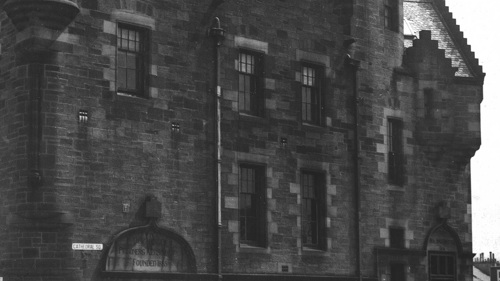Glasgow Discharged Prisoners' Aid Society - Times Past

In partnership with the Glasgow Times, our archivists are exploring Glasgow's fascinating history. This week, Barbara McLean writes about the Glasgow Discharged Prisoners' Aid Society.
Exploring the histories of Glasgow’s older buildings is part and parcel of working in the City Archives. You might find that many of the city’s flats, hotels and business premises were schools, warehouses or local authority buildings in their former life.
Take the Cathedral House Hotel. This beautiful Scots Baronial building in Cathedral Square is now a boutique hotel. However, its former and original use was as a home to the Glasgow Discharged Prisoners’ Aid Society. Some of its records, including cash and subscription books, annual reports and photographs, are held in our collections.
The Society was instituted in December 1856 with the aim of helping former inmates re-establish themselves in the world they’d left behind. The Society was desirous of bringing to bear “a kindly, helpful, Christian influence” and wanted to restore these former prisoners to active citizenship. Help was made available to those prisoners considered respectable by the Society. This did not include those imprisoned for thieving or those who struggled with alcohol.
That help could come in many ways. Firstly, on the day of their release, discharged prisoners were invited to breakfast at the Society’s premises. Initially, the Society was based in St Andrew’s Square, but later moved to Cathedral Square to take up residence in their new, purpose-built premises designed by the architects Campbell, Douglas and Morrison. The Cathedral Square building opened in March 1897 in close proximity to Duke Street Prison.
After breakfast, each former prisoner would then be offered help tailored to their individual circumstances. In some cases, a small sum of money was given but mostly it involved the provision of clothing, food, lodgings, employment, tools and advice. Public support was instrumental in providing this help. Annual subscriptions, donations of money, gifts of clothing and offers to employ former prisoners were all means by which the public could show their support.
The Glasgow Discharged Prisoners’ Aid Society was not alone in offering this kind of aftercare to former prisoners. By 1872, it was one of over thirty such societies in Britain. During the 1850s, transportation as a form of punishment began to be phased out and domestic imprisonment was increasingly used. The growing number of former prisoners and a lack of a formal support system after their release drove the establishment of these societies and their philanthropic work.
By the mid-twentieth century, the context in which the Glasgow Discharged Prisoners’ Aid Society operated had changed. While central and local government now provided more help to former prisoners than previously, the Society continued to provide unofficial aid. They remained separate from government and continued to offer help with the bureaucracy of re-joining society. A key driver at that point was to provide former prisoners with social support. An officer from the Society would visit the former prisoner’s relatives and try to get them back to their friends in the hope that this network would support them in the long run as they re-adjusted.
The Society was wound up in May 1974 and, while it’s no more, both the building and its archives remain.
